EVENTS
It’s been billed as ‘The Glastonbury of Railways’ and the largest collection of historic and contemporary railway vehicles ever assembled. But how did it originate, and what was involved in putting it together? GARY ESSEX looks at the background and logistics of holding The Greatest Gathering.
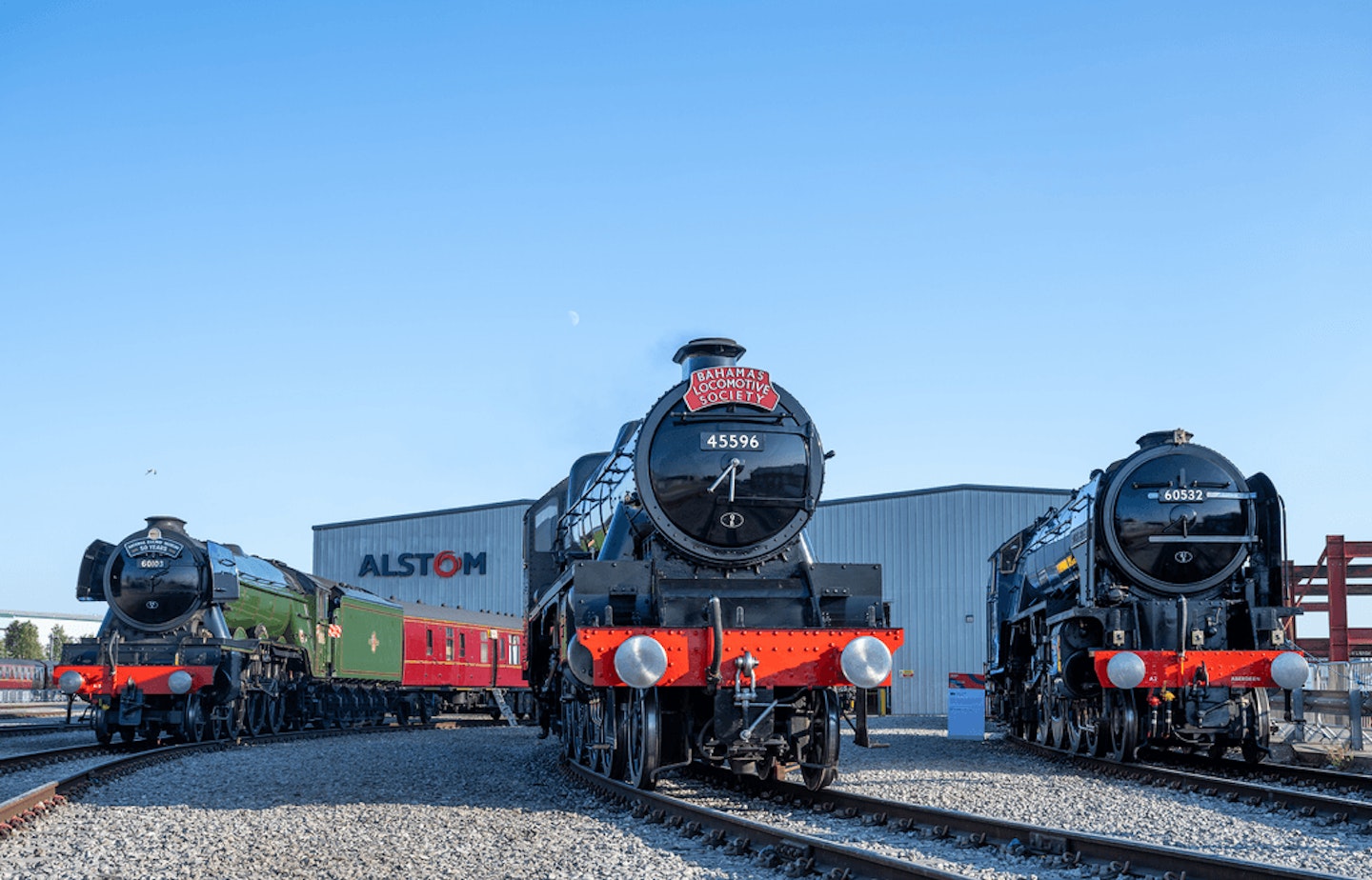
‘A3’ No. 60103 Flying Scotsman, double-chimney ‘Jubilee’ No. 45596 Bahamas, and ‘A2’ No. 60532 Blue Peter – three of the stars of The Greatest Gathering – pose for the camera at Alstom’s Litchurch Lane works in Derby during an evening photo shoot on August 2. JACK BOSKETT
Over 40,000 rail enthusiasts descended on Derby on August 1-3 for The Greatest Gathering. Held at rolling stock manufacturer Alstom’s Litchurch Lane works – which started life as the Midland Railway’s Derby Carriage & Wagon Works in 1876 – the event was the biggest display of locomotives and rolling stock in a generation, featuring 25 complete steam locomotives, as well as numerous diesel and electric locomotives, multiple units, carriages, wagons, and on-track plant.
For those who attended, it was an event that will live long in the memory, and was arguably the highlight of the ‘Railway 200’ celebrations this year.
The original idea for the event came from James Dobson, Operations Delivery Manager at Avanti West Coast and Jonathan ‘Gus’ Dunster, Managing Director of the Severn Valley Railway. Gus, formerly the Executive Director for Operations and Safety at Avanti explains how the event came about.
“The Greatest Gathering came about, like, all good events, over a discussion in a pub. Back in 2019, when I was working for Virgin Trains, we supported an event at Crewe in partnership with Locomotive Services, called Crewe for Change. It was a railway open day raising money for local charities around Crewe. The person behind that was James Dobson, train manager for Virgin. It was on a smaller scale than The Greatest Gathering, but still very successful, and it generated a lot of money for the charities.
“At a Virgin Trains reunion last summer, we started chatting and said, ‘let’s give it another go and do something for ‘Railway 200’ in 2025. There will never be a better opportunity’.
“We quickly ruled out railway maintenance depots. Although some have open days, they’re too full of trains, giving a very compressed window during the day after trains have left and before they return. We needed to find a railway site that wasn’t constrained in the same way, so I suggested the obvious one: Derby Litchurch Lane. It’s centrally located, and well connected. At present there is capacity as they are between orders, so there’s not too many vehicles on the site, although Alstom have now received the order for follow-on trains for the Elizabeth Line and are gearing up for the joint venture with Hitachi on the construction of HS2 trains.
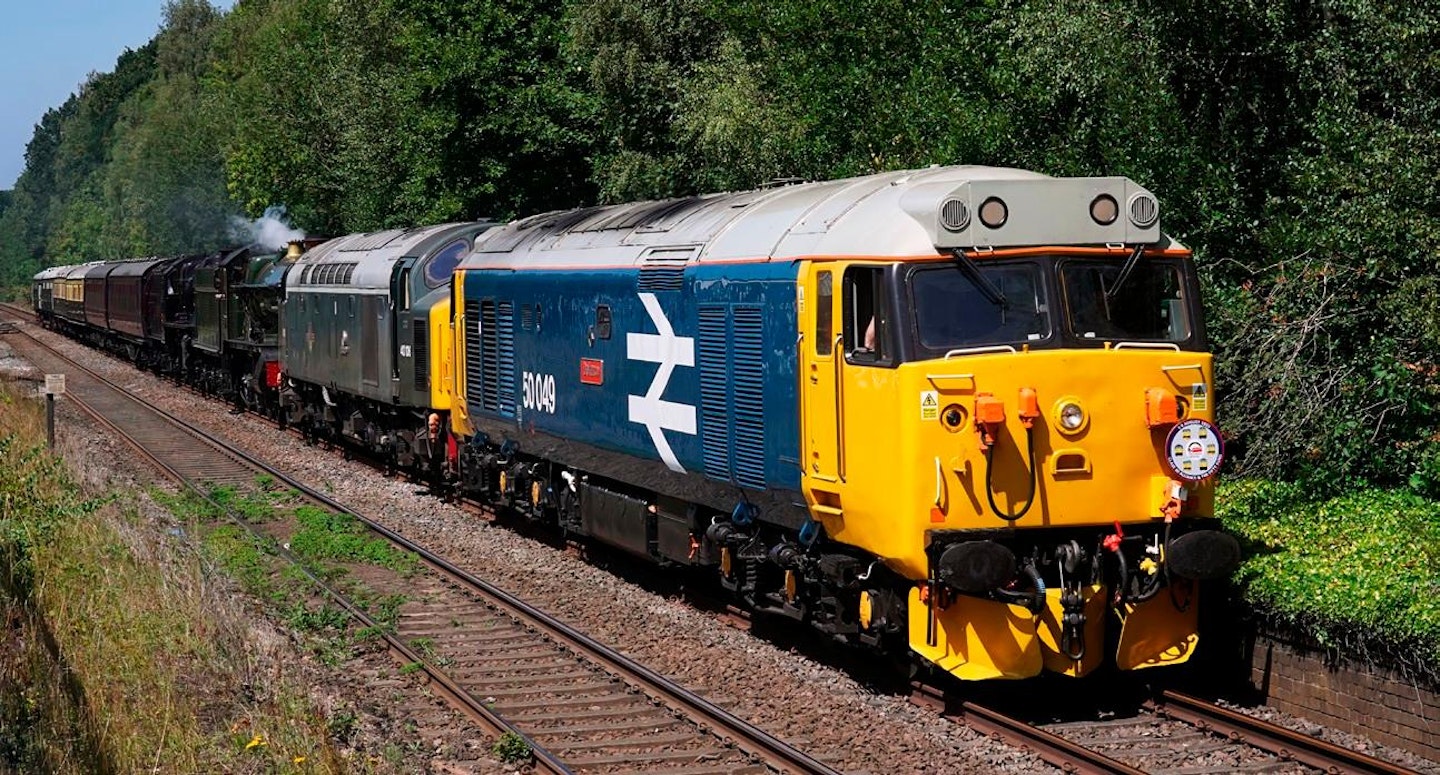
Not a train you see every day! Class 50 No. 50049 Defiance hauls Class 40 No. 40106 Atlantic Conveyor, ‘Hall’ No. 4930 Hagley Hall, LMS Stanier ‘Mogul’ No. 13268, a pair of LMS carriages, a pair of GWR carriages, and a two-car Class 108 DMU to Derby for The Greatest Gathering. IAN NIGHTINGALE
“I spoke to some people I know at Alstom, and they immediately bought into the idea, though we had to wait whilst it went through the company approval process, including the Alstom head office in Paris. It was signed off at the end of August
2024, and the first press announcement went out in early September. The idea was for a pretty substantial exhibition to fit in with ‘Railway 200’ and its overarching principles, to celebrate both the past and the present and to shine a light on the future. Part of that was to show rail industry innovation, and demonstrating to school leavers and graduates that the rail industry is actually quite an attractive place to think about a career.
“Then we hit on the idea of doing a launch event. So, having gone public, people were generally quite enthusiastic about the concept, but there was some cynicism about whether the rail industry could pull something of this nature off, given its fragmented nature. We were determined to prove people wrong. The real catalyst came with the launch on January 30. We assembled a fairly representative selection of stock on site, both heritage and modern.
“That really galvanised interest in the industry, and we had a number of influential people there from the industry and trade press. I think it really brought home to many people who might have been sitting on the fence that this was a serious proposition, and the momentum gained since has been significant, including engagement from uninvolved sections of the industry.
“It then became clear that if we managed it professionally this could be the biggest assembled gathering of railway vehicles that would ever take place in the UK.”
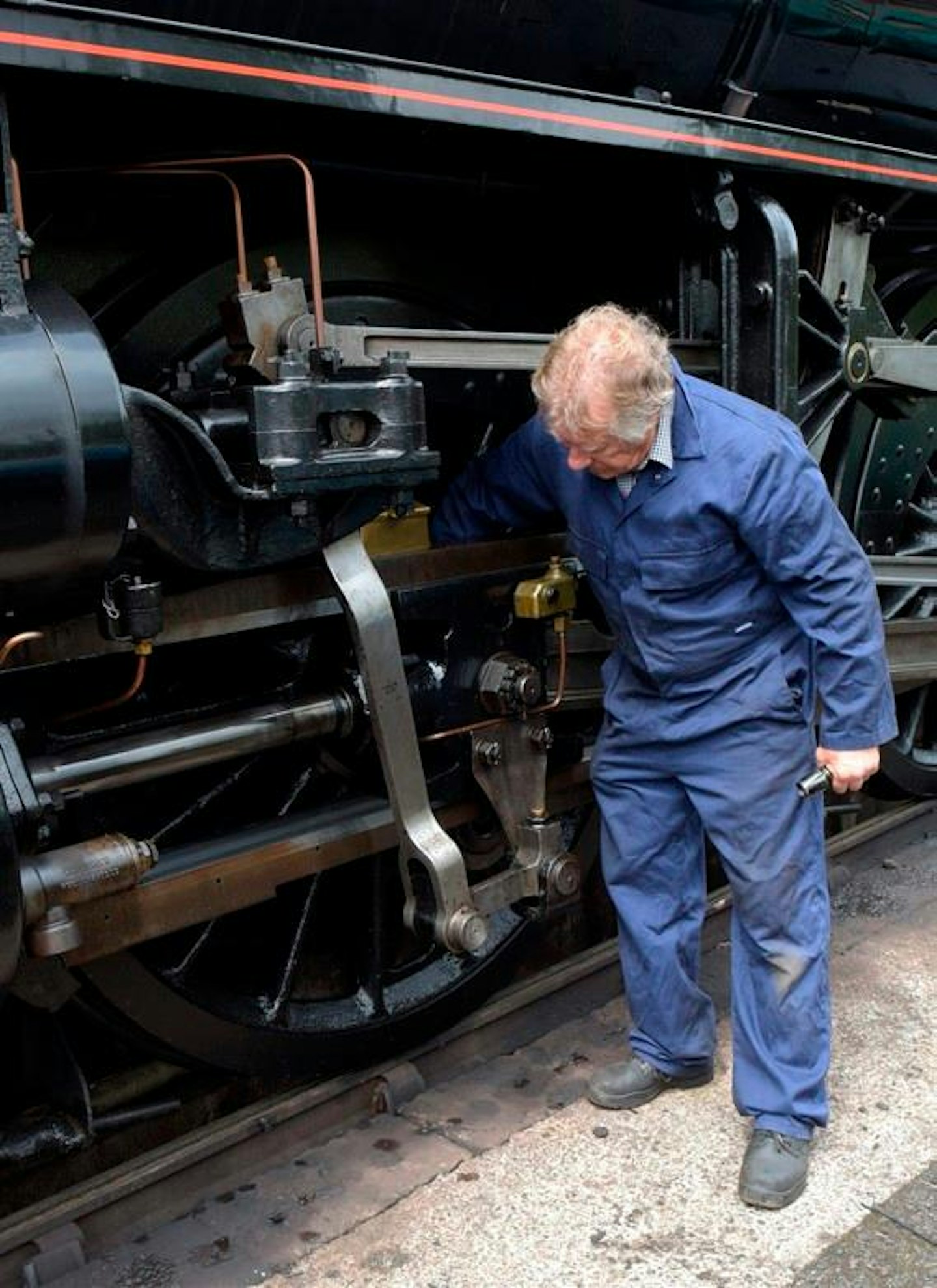
Geoff Armstrong inspects Stanier ‘Mogul’ No. 13268 prior to its main line journey to Derby. GARY ESSEX
Main line return
The headline figures themselves are impressive: 140 items of rolling stock on a 90-acre site, with over 40,000 people either taking part or attending. To enable this to take place, 45 movements to Litchurch Lane on the main line railway and numerous heavy haulage road movements were needed just for the locomotive and rolling stock displays, with dozens more vehicles bringing all the necessary event infrastructure to Litchurch Lane.
Over the weeks building up to the gathering, people all over the UK were working towards getting the display stock prepared and ready to move. Arguably the most unusual arrival on site, and certainly one of the more unusual rail movements seen in recent years, was a rail convoy from the Severn Valley Railway. It comprised GWR ‘Hall’ No. 4930 Hagley Hall, LMS Stanier ‘5MT’ 2 6 0 No. 13268, a two-car Class 108 DMU, two GWR and two LMS carriages, and Class 40 No. 40106 Atlantic Conveyor, all hauled by BR Class 50 No. 50049. Although Hagley Hall had been on main line service back in the 1980s, and the ‘Mogul’ in the 1990s, both needed thorough examinations to ensure they were able to go on the main line, even when hauled by diesel.
The assessment of the Severn Valley locomotives and rolling stock was carried out by an independent traction examiner, Geoff Armstrong. Over a two-day period, he inspected the four carriages, the Class 108 DMU, and Nos. 4930 and 13268, to ensure they were safe to run on the main line. Prior to his assessment, another independent contractor carried out an ultrasonic assessment on all the stock’s axles to check their integrity.
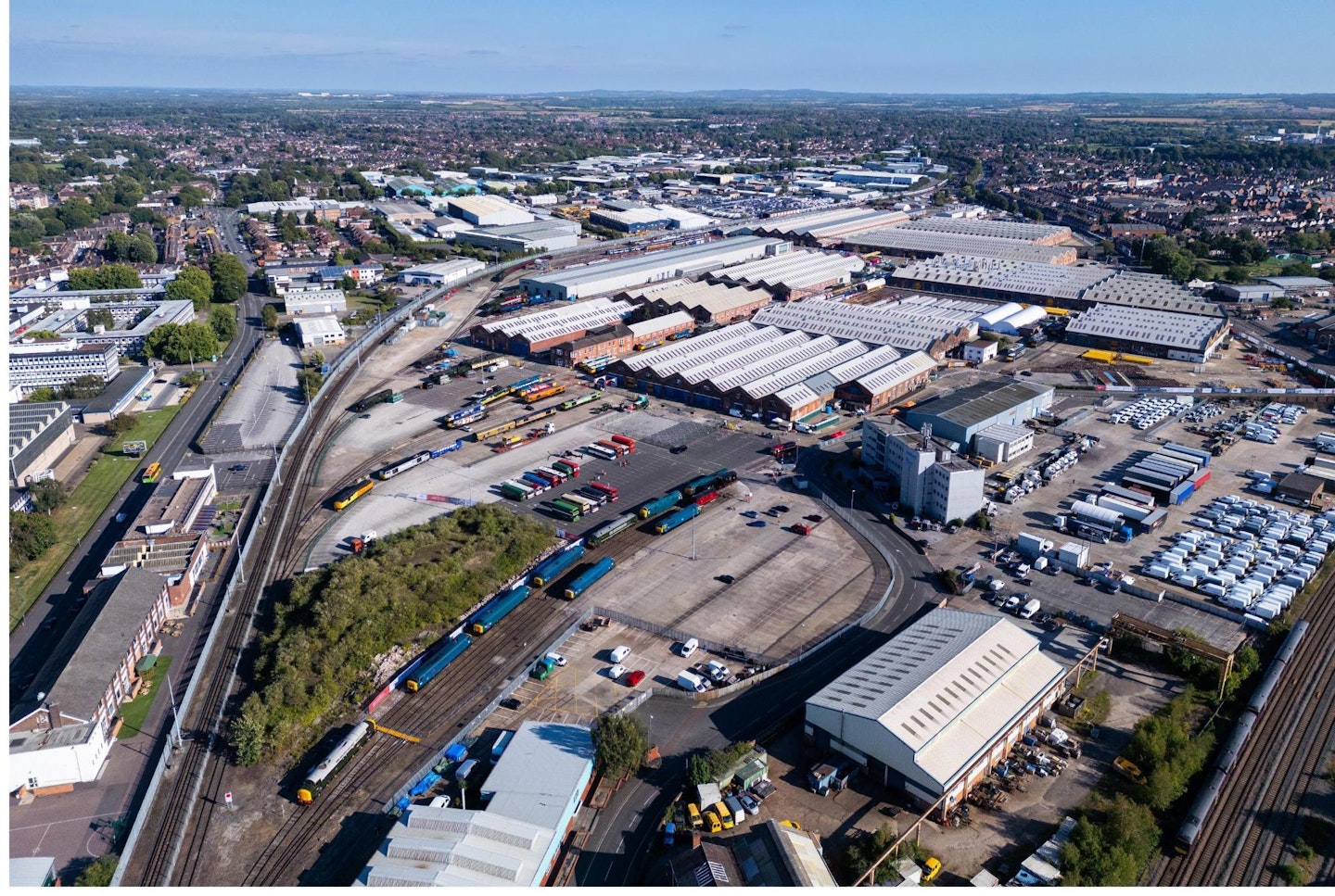
An aerial view of Alstom’s Litchurch Lane works site during The Greatest Gathering, showcasing the vast, 90-acre area in which the event was held. STEVE DONALD
Geoff explains the process: “We’re looking to ensure the stock is safe to run on the main line network. It’s been operated at 25mph for many years on a heritage line, then it suddenly has to operate at speeds up to 60mph for at least an hour, so we need to assess if it will get there without harm to anyone, the network, or the heritage stock itself. It’s also important to ensure the stock won’t fail and block the main line.
“It’s a visual and practical exam. The visual elements ensure that it’s within gauge, everything is secure, including the motion, all securing and locking pins are present and secure, and if there is any sign of movement around rivets and fastenings. We run a functional brake test as well, making sure they both apply and release correctly. The biggest risk is the axleboxes overheating, so we pay attention to horn guides, alignment, lubrication and so on.”
The locomotives were moved in light steam to allow the lubrication system to operate and they were crewed by drivers from West Coast Railways. Once the inspection was complete and the stock passed, a statement of attestation was issued and the vehicle details were passed to the Rolling Stock Library in Nottingham, which is the database of all locomotives and rolling stock passed to operate on the main line. This is where TOPS numbers were allocated to give the stock a trackable number for main line use. The certificate is valid for 28 days, which allowed time to return them back to the SVR after the ‘Gathering’.
Though some of the locomotives and rolling stock being moved by rail to and from the event are over 100 years old, no problems arose. The only issue was a suspected brake fault on Sarah Siddons, the ex-Metropolitan Line Bo Bo electric locomotive, part of the Transport For London heritage fleet. She was removed from its train at Leamington Spa for inspection before onward movement to Derby.
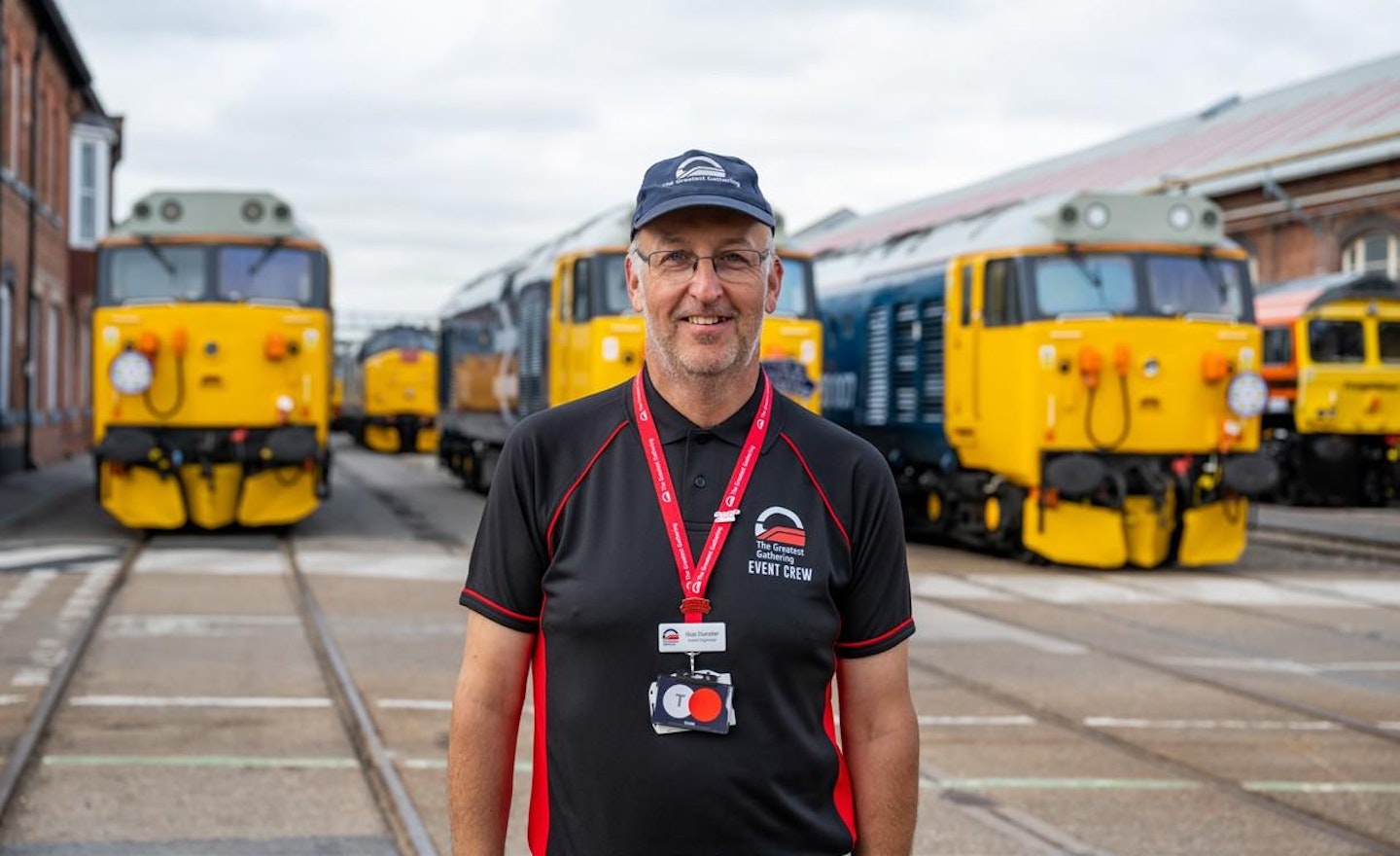
Jonathan ‘Gus’ Dunster – one of the brains behind The Greatest Gathering. JACK BOSKETT
Road to Derby
The locomotives moved by road have all been transported by Allelys, the specialist heavy haulage company which regularly transports locomotives to and from heritage railways across the UK. For the Greatest Gathering, they have moved more than 30 steam and diesel locomotives from over 12 different locations, the furthest being the Plym Valley Railway’s Sentinel 0 4 0DH No. 10077, from its base at Marsh Mills, Plymouth.
The oldest locomotive on display was Locomotion, the original 1825 Stockton & Darlington Railway locomotive. Normally residing at the National Railway Museum’s site at Shildon, it was carefully prepared for transport to the event by Allelys’ heritage and museum projects department in conjunction with NRM staff. Appropriately, as one of Britain’s oldest steam locomotives, it was displayed alongside one of the newest – the part-built new-build BR ‘3MT’ 2 6 2T No. 82045, which also came from the Severn Valley.
A specially designed support frame created by the NRM was used under Locomotion. The frame gets used for internal moves and on the recent exhibition moves to Hopetown Darlington and, of course, to Derby. Locomotion is not able to move on its own wheels due to their age and fragility, and its other components, and it has a smaller display frame for long duration static displays.
This transport frame allows it to be lifted by crane, on machine skates or to have rail wheels attached to move it around easily and safely. Both the locomotive and tender were fully crated for the move to protect it from the elements.
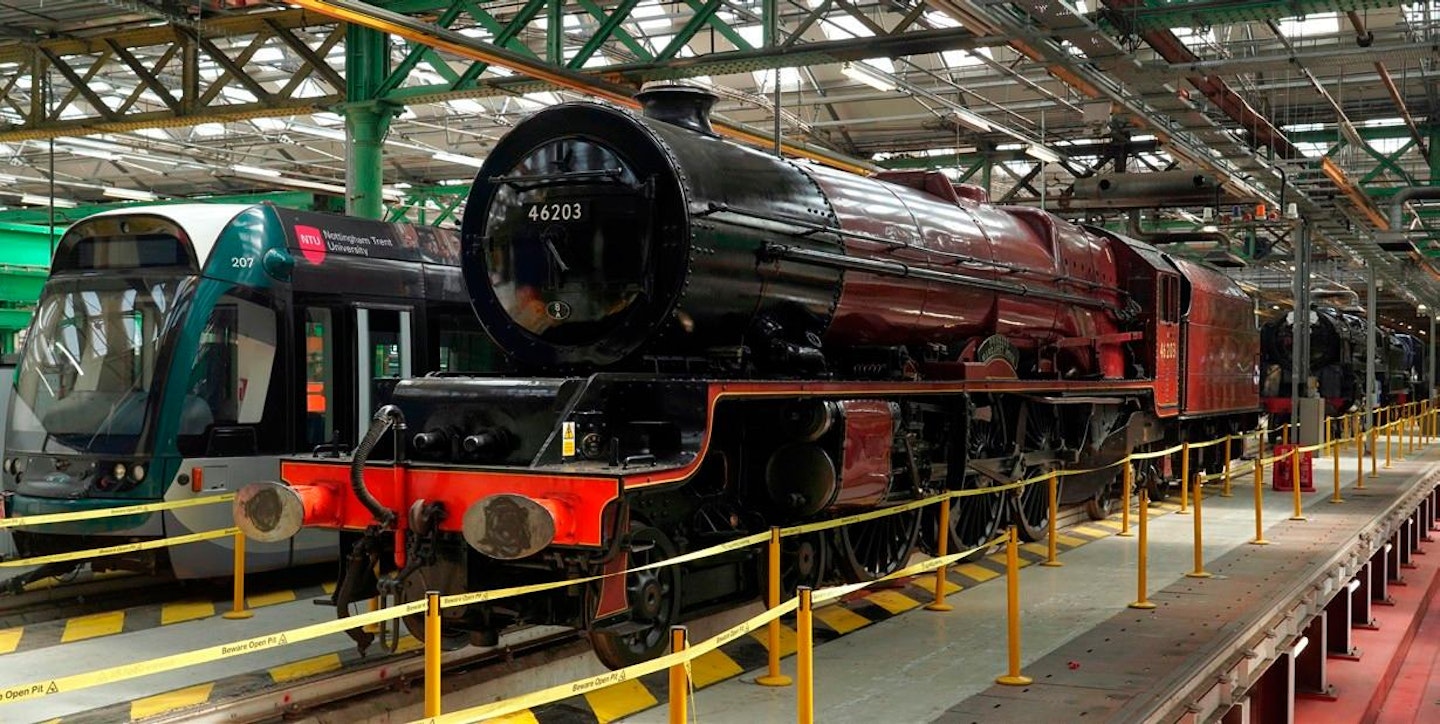
One of the headline steam locomotives was ‘Princess Royal’ No. 46203 Princess Margaret Rose, making its first visit away from its West Shed home in 20 years. The Stanier 462 has a unique link with Derby, when it became the only LMS ‘Pacific’ to visit the former Midland works when it required attention to its outside cylinders in 1951/52. Just visible behind the ‘Lizzie’ is ‘9F’ No. 92214 and ‘King’ No. 6023 King Edward II. IAN NIGHTINGALE
Making the selection
The event has a diverse range of displays, from _Locomotio_n through to a Eurostar power car and one of the new Class 99 tri-mode freight locomotives that are the newest additions to the UK’s train fleet. How were the exhibits decided on and how easy was it to arrange them?
Gus Dunster continues: “In terms of the exhibits, for standard gauge, that’s fallen to myself and James to manage. As you might imagine, we were inundated with offers. We wanted a fairly representative selection of railways past, present and future. Some of the decisions were based on emotion, if you like, because we know that certain exhibits will be popular with visitors. Some we’ve had to be more pragmatic about as the logistics wouldn’t be possible or cost-effective.
“The selection has had to be based on logistics and what can reasonably work on the ground and what can be afforded. And some decisions have been based on the idea that we’ve just got to have certain things at the event.
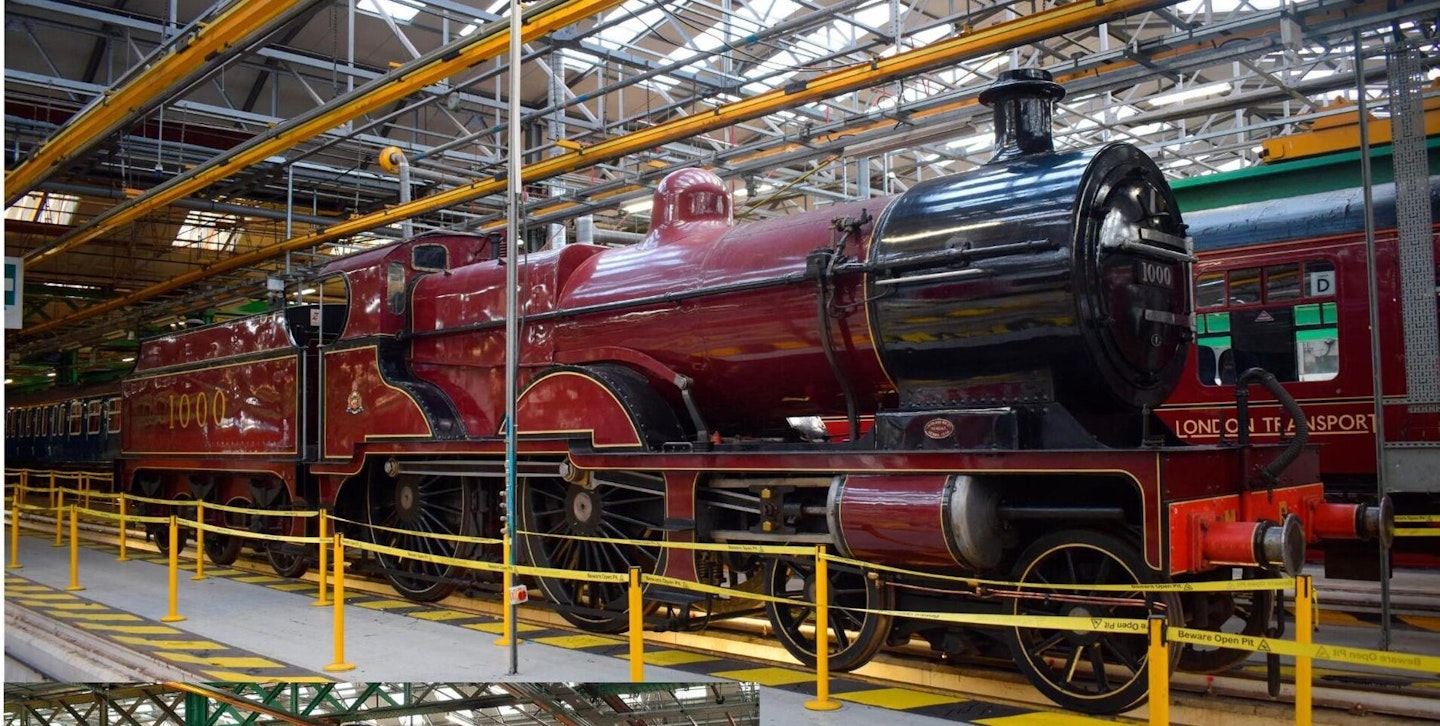
The Greatest Gathering wouldn’t have been complete without some Derby-built steam locomotives. Returning ‘home’ for the event was Midland ‘Compound’ 440 No. 1000, which was parked up next to London Underground’s 4TC set. THOMAS BRIGHT/SR
“The obvious one was Flying Scotsman. We can’t have an event of this nature and not have Flying Scotsman there. And it can be a bit Marmite to some railway enthusiasts, but from my point of view and a historical point of view, it was at the Shildon cavalcade in 1975 and the ‘Rocket 150’ event at Rainhill in 1980, and it’s historically important, so it’s absolutely right that it should be at this event.
“We tried to get early locomotives, but for various reasons some were unable to be moved. Locomotion is really important and we’ve managed to get it to Derby. On the steam side, we didn’t set out with a particular amount of exhibits in mind, though we both thought that if we can get 20-plus steam exhibits, that would be quite representative. Picking 20 relevant steam locomotives has been quite difficult, and we’ve had some drop out and some replaced, so a bit by design, a bit by osmosis.
“And there have been some surprises. We were after a ‘9F’; they are part of the story of freight, and the last steam operations of freight traffic. But there’s not many around and those that still exist can’t be moved by rail, so it’s rather limiting, so we were very pleased to get the offer from the Great Central Railway of 92214. Although it’s not currently steamable, it’s not long out of its boiler ticket and it is still very presentable.
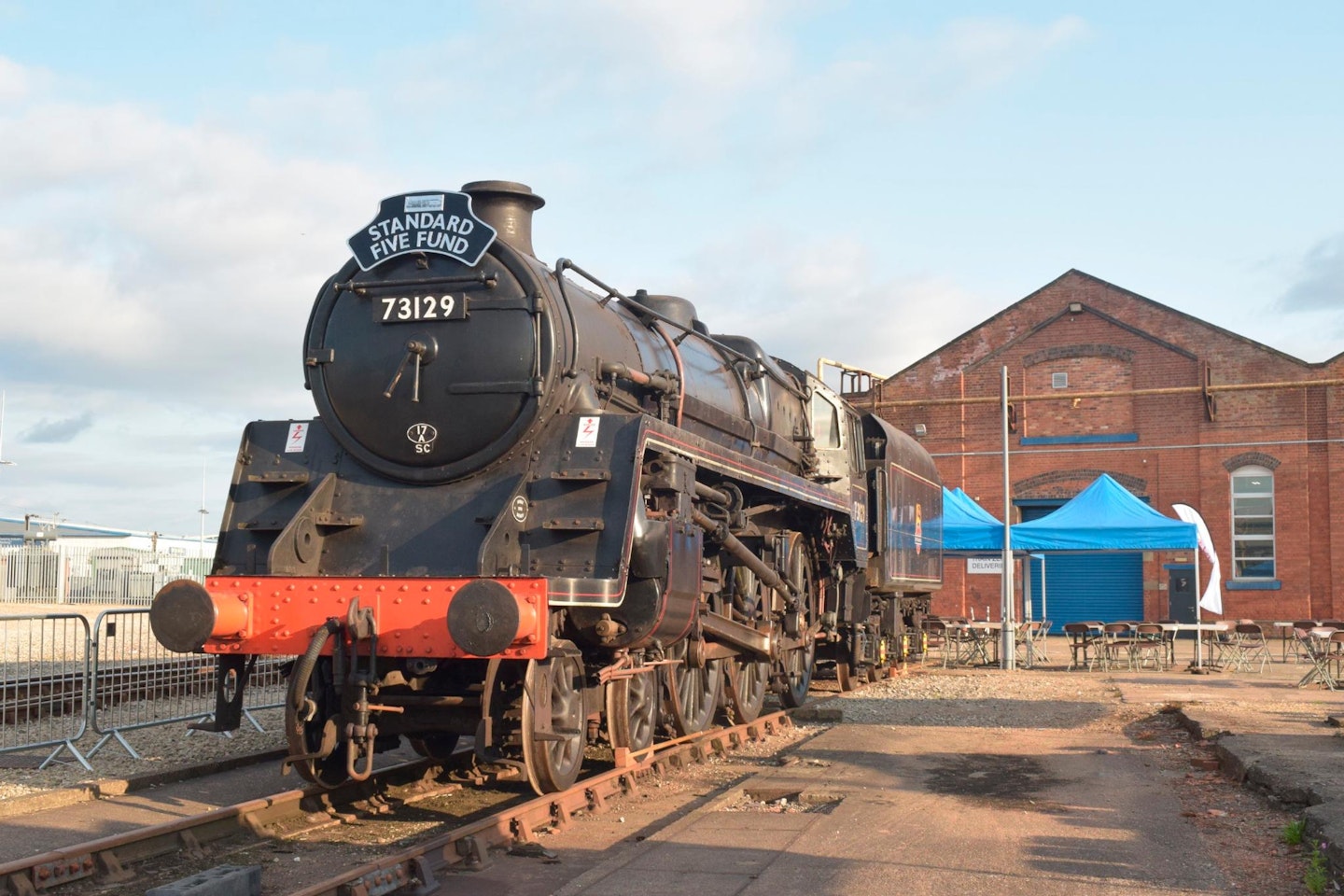
Another locomotive returning to the city of its birth was unique surviving Caprotti valve geared BR ‘5MT’ No. 73129, appearing from the Midland Railway – Butterley. THOMAS BRIGHT/SR
“Another I was pleased to get was the new-build ‘3MT’ 262T 82045 from the Severn Valley, because that represents 21st-century steam, and it has the first all-riveted boiler constructed in the UK since the end of steam on the main line. The locomotive is almost complete, with the boiler, built at Bridgnorth, now finished and fitted into the frames. We’ve displayed it next to Locomotion, bringing the story of UK steam right up to date.”
Gus continues: “Having a number of exhibits in steam was always the intention, along with the on-site test track for modern rolling stock, which gives people a ride on modern traction and I’m sure there will be people who want to add the Litchurch Lane test track to their mileage.
“We had a separate line for main line steam and some of the static locomotives were in light steam, and for some of the narrow gauge exhibits we built temporary lines there for the event, as well as the model engineering groups, so there were quite a number of engines in steam.
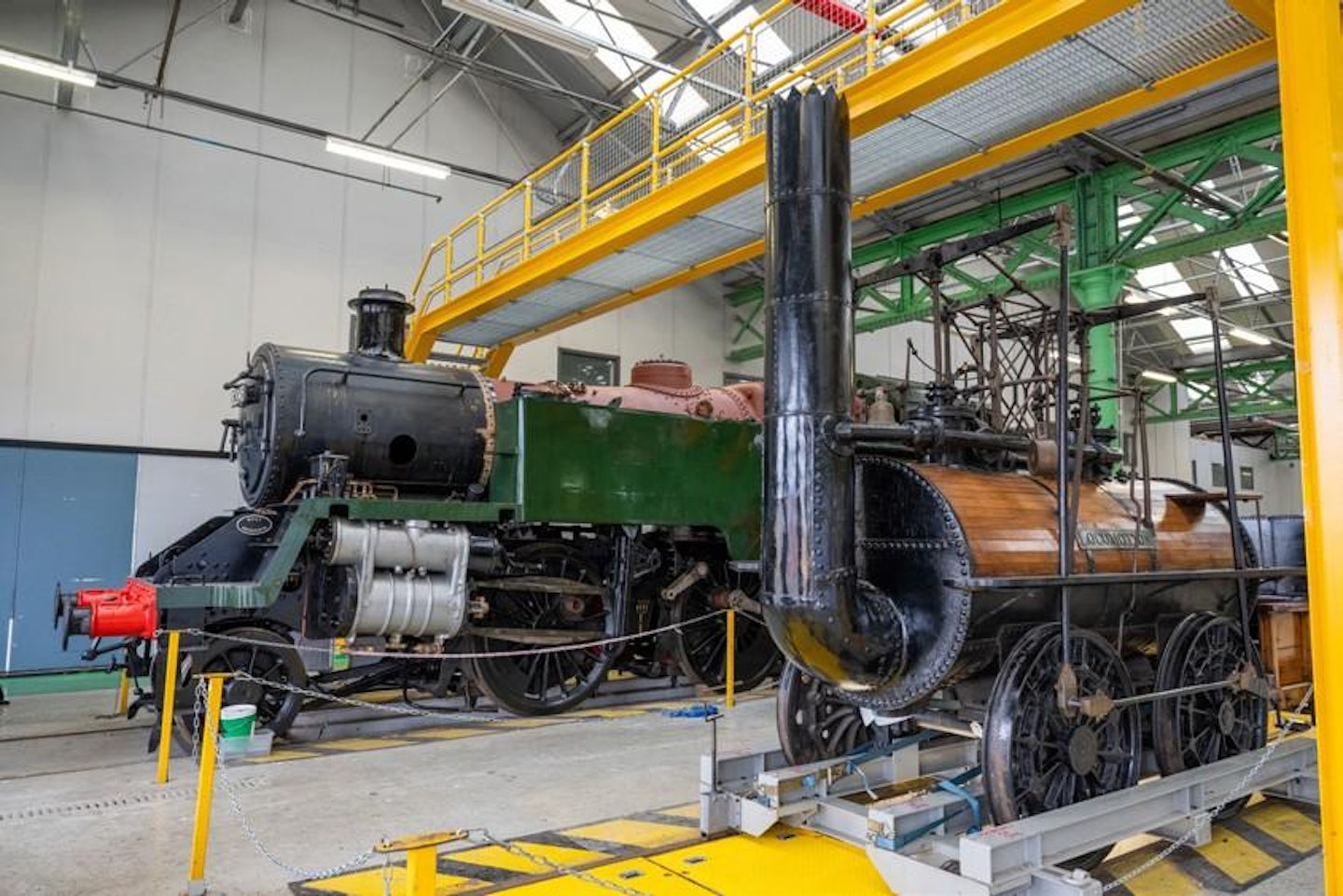
Old meets new. 1825-built Stockton & Darlington veteran Locomotion stands alongside the almost-complete BR ‘3MT’ 262T No. 82045. THOMAS BRIGHT/SR
“In terms of modern traction, we were really pleased to get the Eurostar Class 373 power car, though that had to come by road, as it’s out of gauge for much of the UK network, apart from the HS1 and associated lines of course.
“There were, of course, a few exhibits we would have liked to have seen on site. On a personal level, I would have really liked to have the prototype Deltic; I think that of all the modernisation scheme locos, it was just the most eye-catching. And we had a discussion with the National Railway Museum about the possibility, and they clearly understood why we wanted it, but there were a number of strong logistical reasons why that couldn’t happen.”
There were steam-hauled trains on three gauges across the weekend, with ‘Jubilee’ No. 45627 Sierra Leone (in reality No. 45699 Galatea) on one of the standard gauge test tracks, with Prince and Trangkil No. 4 operating top-and-tail on the temporary 2ft gauge test track, and Katie and Anne working top-and-tail with a rake of Perrygrove Railway carriages on the temporary 15in gauge test track, the materials for which were provided by the Cleethorpes Coast Light Railway. Ironically, despite being the smallest gauge, the 15in gauge line was the only one of the steam-hauled trio to have any wheelchair/disabled access provision.
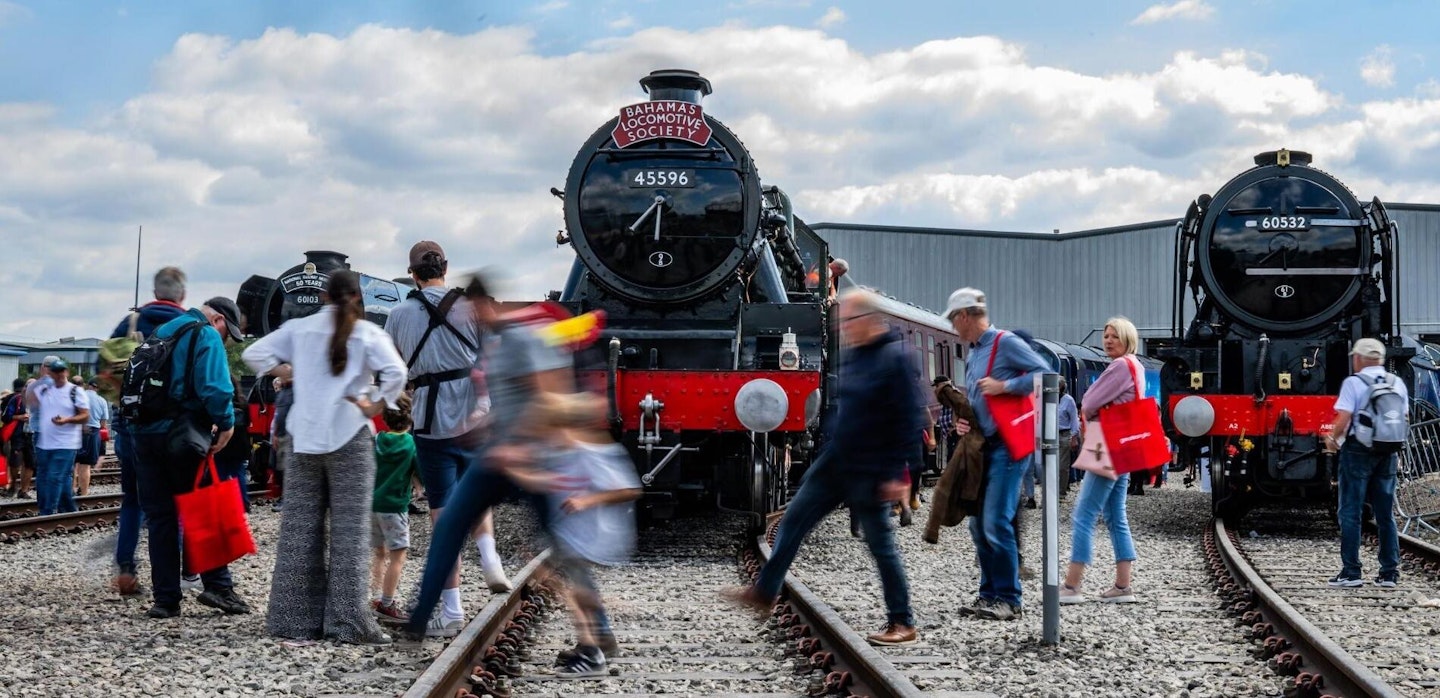
Crowds swarm over the tracks to get a look at Flying Scotsman, Bahamas and Blue Peter at The Greatest Gathering. JACK BOSKETT
Good timing
The timing of the event at the start of August was planned to coincide with the annual holiday shutdown fortnight, although 300 Alstom staff volunteered across the event days to help manage the event and guide people around the site, as well as for the install and take-down days either side.
Staff volunteered from across Alstom’s 37 sites across the UK and Ireland, and from sites in the rest of Europe. The CEO of Alstom, Henri Poupart-Lafarge, also visited from France and spoke at the official opening.
The staff at Alstom have obviously been closely involved in the planning and logistics of opening up their factory site to the public; most areas are accessible, though several of the buildings are closed for operational reasons.

Ex-Eaton Hall Railway 0 4 0T Katie looks somewhat incongruous next to Class 92 AC/DC Co Co electric locomotive No. 92011 at The Greatest Gathering. JACK BOSKETT
Two members of Alstom staff have been working almost full time on the event since January. Ben Goodwin, Communications Director, and Kathryn Lancaster, Communications Manager, have been overseeing the logistics and planning of the event and have been working with Derby City Council and train operators East Midlands Railway and Cross Country to streamline access to the site, encouraging as many people as possible to arrive by rail.
Several main line railtour operators also planned services to arrive at Derby for the event, including Vintage Trains and Belmond – with Flying Scotsman making its first revenue-earning foray onto the main line since December 2023 at the head of Belmond’s ‘British Pullman’ from Wellingborough on the Saturday. And, in a refreshing contrast to recent main line railtours, it did so without diesel assistance.
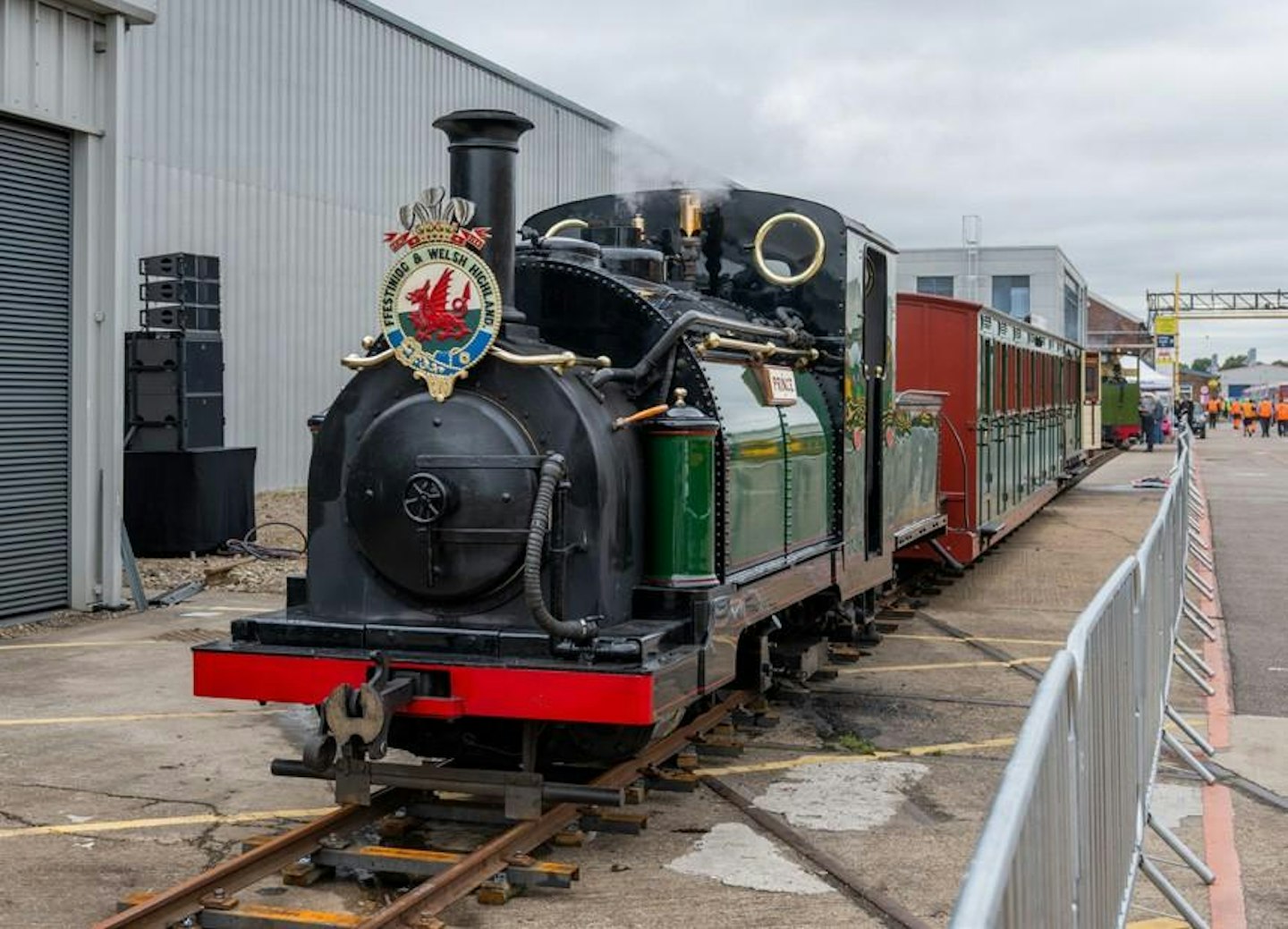
It wasn’t all about standard gauge steam. Britain’s oldest narrow gauge locomotive, 1863-built Ffestiniog Railway ‘Small England’ Prince, top-and-tailed with 1971-built Hunslet 0 4 2ST Trangkil No. 4 – the last steam locomotive built in Britain for commercial use – throughout The Greatest Gathering. JACK BOSKETT
Ben Goodwin commented on why Alstom had agreed to host the three-day spectacular: “I think we had an obligation to host The Greatest Gathering! Given that we have one of the world’s largest rolling stock factories, we’re connected to the national network, and we’re currently between major orders, we’re perhaps the only site in the country that could put on an event of this size during ‘Railway 200’. The timing has been perfect; any earlier or a bit later and we simply wouldn’t have been able to accommodate a record-breaking roster of locomotives. We’ve just finished the country’s largest train-building programme in a generation – manufacturing 2,660 Aventra cars for customers across the UK over the last ten years – and literally the day after The Greatest Gathering finished, we started work on ten new units for the Elizabeth Line.
“Admittedly, the modern railway began in England’s North East, but Alstom has a legitimate claim there too. Through our acquisition of Robert Stephenson and Company – the Newcastle-upon-Tyne builders of Locomotion – we can draw a direct line from the dawn of the modern railway in 1825 to today’s cutting-edge mobility solutions.”

Time to reflect. Furness Railway 0 4 0 No. 20 – Britain’s oldest operational standard gauge locomotive – stands in the line-up behind ‘Royal Scot’ No. 46115 Scots Guardsman, and in front of ‘Hall’ No. 4930 Hagley Hall and Stanier ‘Mogul’ No. 13268 and their respective pairs of GWR and LMS carriages. JACK BOSKETT
A lasting legacy
The event had no sponsors or financial backers; the ticket sales covering the costs of holding the event, with the surplus going to charity. The initial ticket sales gave the organisation enough working capital to begin preparations. All the rolling stock owners waived appearance fees, but plenty of other unavoidable costs needed to be covered, including exhibit transport to site, insurance, facilities, staffing and security for the site and the exhibits.
The remaining surplus after all the event overheads are covered will then be split between ‘Railway 200’s’ five chosen charities – Alzheimer’s Research UK, Railway Benefit Fund, Railway Children, Railway Mission, and Transport Benevolent Fund CIO – and charitable railway heritage partners.
Ben spoke about the legacy of the event and Alstom’s involvement: “All those involved hope The Greatest Gathering excites interest from the next generation and encourages young people of all backgrounds to consider a career in rail. As a result, we designed The Greatest Gathering to be family friendly and engaging for all age groups. A whole host of interactive science, technology, engineering and maths activities were available among the rolling stock exhibits, while partners from across our industry showcased a host of career pathways.
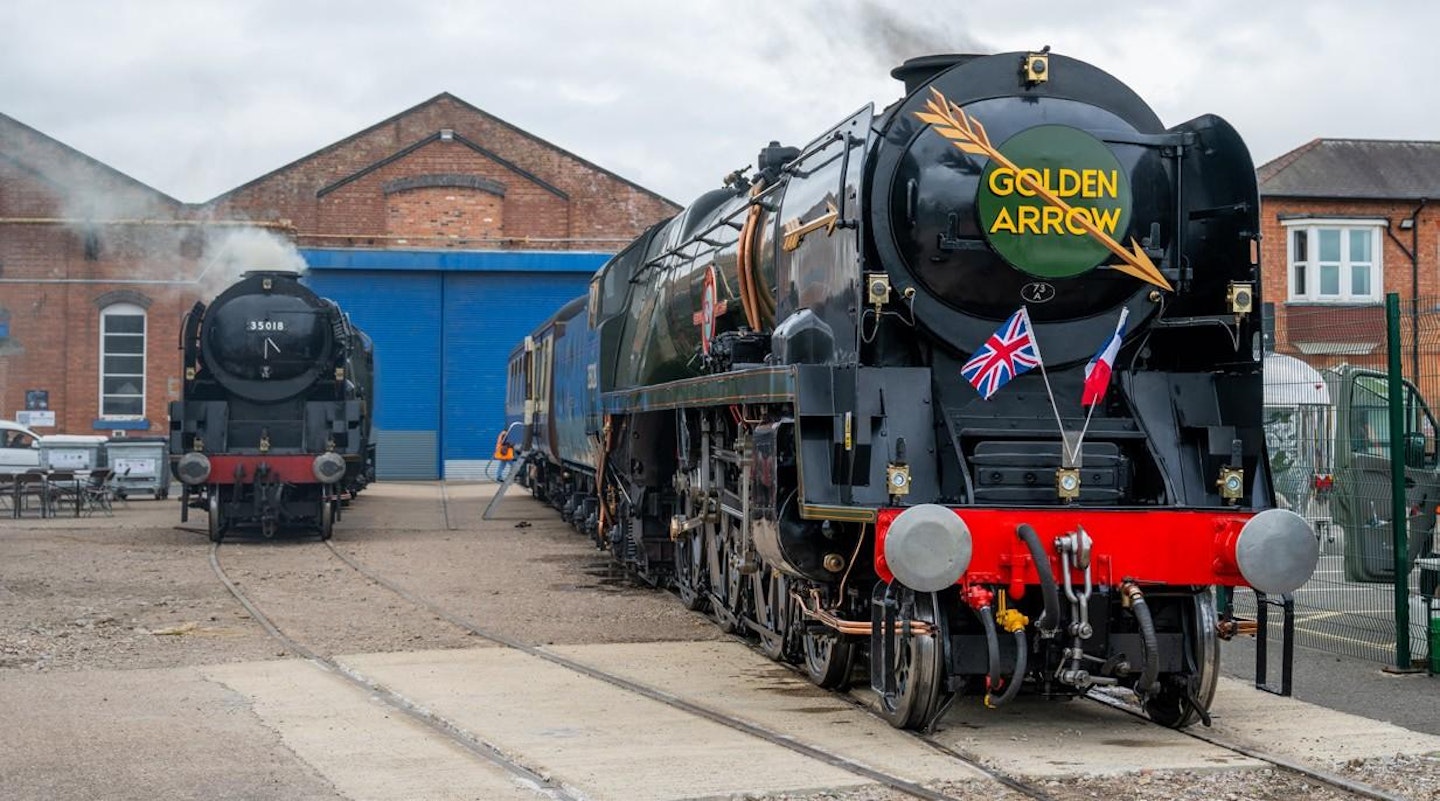
‘Merchant Navy’ No. 35028 Clan Line, adorned with full ‘Golden Arrow’ regalia, stands next to classmate No. 35018 British India Line outside ‘K’ shop at Litchurch Lane. JACK BOSKETT
“Other than that, I’d love us to be remembered as the Glastonbury for railfans! ‘Railway 200’ has given us a unique opportunity to celebrate not only the incredible progress of the past two centuries but also the bright future of rail. We’ve truly been blown away by the support from across our industry to put on this event, which we hope will be remembered as fondly as previous events such as ‘Rail 150’, Railfest and The Gathering in Crewe.”
While enthusiasts will inevitably debate ad infinitum about what exhibits should or should not have been there – industrial steam was noticeable by its absence – and while the hoped-for line-up of an LNER ‘A1’, ‘A2’, ‘A3’ and ‘A4’ side-by-side did not ultimately happen (although all four representative locomotives were on-site during the event), no one can deny that The Greatest Gathering was an event for the ages. By the time you read this, Alstom will have already started on its new Elizabeth Line units; the last vestiges of the event will have been tidied away and the various exhibits will have returned home. It will be almost like it never happened.
But for those who were there, it will remain etched in our collective memories. We might not be treated to a cavalcade on the scales of those in 1975 and 1980, but The Greatest Gathering will undoubtedly go down in history as the unparalleled highlight of the ‘Railway 200’ festivities.
THE GREATEST GATHERING – THE STEAM LINE-UP
STEAM (STANDARD GAUGE)
S&DR No. 1 Locomotion**:** National Railway Museum
Furness Railway No. 20: Furness Railway Trust
Midland Railway ‘Compound’ No. 1000: National Railway Museum
LNWR ‘Coal Tank’ No. 1054: Bahamas Locomotive Society
LNWR ‘George the Fifth’ No. 2013 Prince George****:** LNWR George the Fifth Steam Locomotive Trust
GWR ‘Hall’ No. 4930 Hagley Hall: Severn Valley Railway
GWR ‘King’ No. 6023 King Edward II: Great Western Society
LMS Stanier ‘Mogul’ No. 13268: Stanier Mogul Fund
SR ‘Merchant Navy’ No. 35018 British India Line: West Coast Railways
SR ‘Merchant Navy’ No. 35028 Clan Line: Merchant Navy Locomotive Preservation Society
LMS ‘Black Five’ No. 44932: West Coast Railways
LMS ‘Jubilee’ No. 45596 Bahamas: Bahamas Locomotive Society
LMS ‘Jubilee’ No. 45699 Galatea*: West Coast Railways
LMS ‘Royal Scot’ No. 46115 Scots Guardsman: West Coast Railways
LMS ‘Princess Royal’ No. 46203 Princess Margaret Rose: Princess Royal Locomotive Class Trust
LNER ‘A4’ No. 60007 Sir Nigel Gresley: Sir Nigel Gresley Locomotive Trust
LNER ‘A3’ No. 60103 Flying Scotsman: National Railway Museum
LNER ‘A1’ No. 60163 Tornado: A1 Steam Locomotive Trust
LNER ‘A2’ No. 60532 Blue Peter: Locomotive Services Group
LNER ‘B17’ No. 61673 Spirit of Sandringham**: B17 Steam Locomotive Trust
BR ‘Clan’ No. 72010 Hengist: The Standard Steam Locomotive Co.
BR Caprotti ‘5MT’ No. 73129: Midland Railway – Butterley
BR ‘3MT’ 262T No. 82045: 82045 Steam Locomotive Trust
BR ‘9F’ No. 92214: Great Central Railway *appearing as No. 45627 Sierra Leone ** Parts only
STEAM (NARROW GAUGE)
‘Small England’ No. 2 Prince**:** Ffestiniog Railway
Hunslet ‘Brazil’ 042ST Trangkil No. 4: Statfold Narrow Gauge Museum Trust
Eaton Hall Railway Heywood 040T Katie**:** Ravenglass & Eskdale Railway
Exmoor Steam Railway 062T Anne**:** Perrygrove Railway
STEAM-ERA CARRIAGES (not including support coaches etc)
Brown, Marshall Bogie Brake & Luggage Van No. 10: Ffestiniog Railway
Brown, Marshall Compartment Composite No. 16: Ffestiniog Railway
GWR 57ft bow-end Composite No. 6045: Great Western (SVR) Association
LMS Restaurant First Open No. 7511: Severn Valley Railway
GWR Non-descript Saloon No. 9103: Great Western (SVR) Association
LMS Corridor Composite No. 24617: Severn Valley Railway
LNWR Chairman’s Special Saloon No. 45000: Princess Royal Class Locomotive Trust
LMS Bogie District Engineer’s Saloon No. 42029: Transport for London
LMS Dynamometer Car No. 45050: Princess Royal Class Locomotive Trust
Want to read more articles like this? Subscribe to a Steam Railway subscription today.
